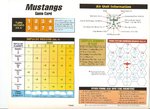fastmongrel
1st Sergeant
The P-51B would out perform the D in every category except firepower and visibility.
B/C models with the Malcolm hood were supposed to have better visibility in certain areas than D/K models with the teardrop canopy. Been looking but cant find the source for this claim but I believe the Malcolm hood had more room for the pilot to twist and look downwards/rearwards.
Last edited:

